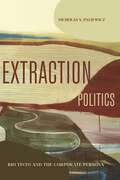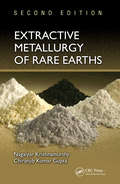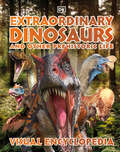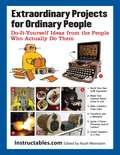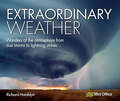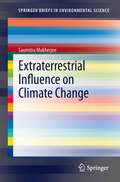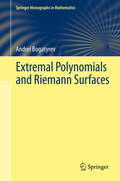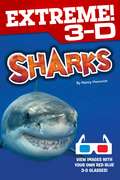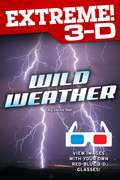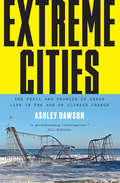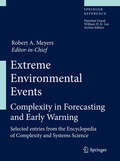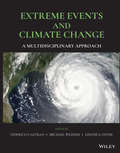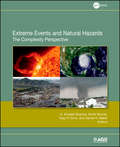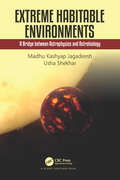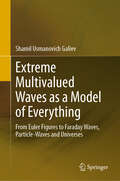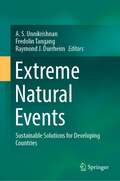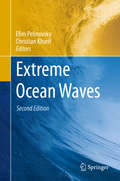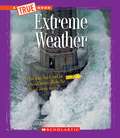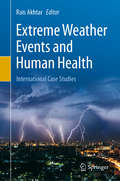- Table View
- List View
Extraction Politics: Rio Tinto and the Corporate Persona (RSA Series in Transdisciplinary Rhetoric)
by Nicholas S. PaliewiczAn investigation into one of the largest and most lucrative mineral mining companies in the world, Rio Tinto, Extraction Politics reveals how the company constructs a presence in the places it operates and shapes meanings and orientations toward the environment. Taking readers on a “rhetorical pilgrimage” across the American Southwest, Nicholas Paliewicz shows how Rio Tinto creates adaptable corporate identities. From Ronald Reagan’s frontiersman advertisements for the Borax Mine in California to the pioneer Mormon persona at Bingham Canyon Mine in Salt Lake City and the folksy, paternalistic perspective toward the San Carlos Apache at the proposed mine at Oak Flat, Arizona, the company appropriates local history to embed itself as a valued member of the public—without having to settle in those ecological communities and bear the costs of extraction. This does not occur without resistance, however. Paliewicz also shows how activists use these same tactics to expose Rio Tinto as an exploitative, colonialist polluter.In an era of surging demand for dwindling supplies of minerals and metals, this book previews what the future of extractivism may look like. Extraction Politics will appeal to scholars and students of environmental communication and activist politics as well as general readers interested in the climate crisis.
Extractive Industry Indigenisation in Zimbabwe: Neoextractivism, Resource Nationalism and Uneven Development (Routledge Studies of the Extractive Industries and Sustainable Development)
by Kennedy MandunaThis book explains how and why Zimbabwe’s extractive industry Indigenisation over-promised its benefits yet under-delivered upon implementation.This book traces the history of uneven development in Zimbabwe from the initial days of colonialism to the present, using the extractive industry as the unit of analysis to carve out a granular and empirical analysis of the preponderance of transnational corporate control and ownership in the country. Indigenisation of Zimbabwe’s extractive industries was intended to address mining inequalities by transferring wealth from rich non-Indigenous mining capital to disadvantaged Indigenous citizens and communities. This policy, however, was a response to political, economic, and social crises posed by the international isolation of Zimbabwe’s government following the controversial Fast Track Land Reform Programme in 2000–2003. An intervention, therefore, which promised to address inequalities has thus been hampered by corruption, co-optation, and collusion which has led to it not only failing to address uneven development, but in actual fact worsening the situation. By examining the hidden structures and infrastructures of power, capital, and minerals and placing extractive industry Indigenisation in capitalism, this book makes a crucial scholarly contribution to the renewed and burgeoning debates around the resurgence of resource nationalism in general and the struggle for economic sovereignty in particular. This book steers readers more broadly to look for new and diversified ways of empowering Indigenous populations and their communities through mining Indigenisation in ways that do not threaten economic and political stability.This book will be of great interest to students and scholars of the extractive industries, natural resource management, African politics, and African development.
Extractive Metallurgy of Rare Earths
by Nagaiyar Krishnamurthy Chiranjib Kumar GuptaNew Edition Now Covers Recycling, Environmental Issues, and Analytical DeterminationEmploying four decades of experience in the rare metal and rare earths industry, the authors of Extractive Metallurgy of Rare Earths, Second Edition present the entire subject of rare earth elements with depth and accuracy. This second edition updates the most impor
Extraordinary Dinosaurs and Other Prehistoric Life Visual Encyclopedia
by DKDiscover more than 100 dinosaurs and other prehistoric animals in this exciting children&’s dinosaur encyclopedia! Extraordinary Dinosaurs Visual Encyclopedia is the perfect book for young readers who want to get up close and personal with their favourite prehistoric creatures! Children will be excited to see the fastest, largest, and fiercest creatures, browse their habitats, learn about their claws and spikes, and find out how their fossils help scientists piece together hidden clues about their lives.This must-have dinosaur book for children aged 7–11 features fascinating information on all the major types of dinosaur as well as ancient fish, other prehistoric reptiles in the air or water, and early mammals. Kids will be drawn in and mesmerized by hundreds of exciting images and surprising information on many different dinosaur profiles.Inside the pages of this thrilling dinosaur book for kids, you&’ll find:- More than 100 profiles on dinosaurs and other prehistoric creatures- Fact-filled &‘top trump&’ style profiles on remarkable dinosaurs and other prehistoric creatures- Chapters that span time before the dinosaurs, the age of the dinosaurs, and life after many dinosaurs died out- Clear, engaging text packed with latest facts alongside stunning CGI visuals and artworksThis is the ultimate fact-filled dinosaur reference book for kids who love to have all the latest, weirdest, most in-depth info on the creatures of the prehistoric world at their fingertips. Dinosaur reconstructions and the latest fossil finds bring back to life the bone-crunching teeth of the Tyrannosaurus rex, the astonishingly large body of the Argentinosaurus, and the plane-sized wings of the soaring Hatzegopteryx. Each page reveals new facts from the latest paleontological research, including each animal&’s size, group, habitat, time period, diet, and fossil discovery.
Extraordinary Projects for Ordinary People: Do-It-Yourself Ideas from the People Who Actually Do Them
by Instructables. Com Noah WeinsteinCollected in this volume is a best-of selection from Instructables, reproduced for the first time outside of the web format, retaining all of the charm and ingenuity that make Instructables such a popular destination for internet users looking for new and fun projects designed by real people in an easy-to-digest way. <p><p> Hundreds of Instructables are included, ranging from practical projects like making a butcher block counter top or building solar panels to fun and unique ideas for realistic werewolf costumes or transportable camping hot tubs. The difficulty of the projects ranges from beginner on up, but all are guaranteed to raise a smile or a “Why didn’t I think of that?” <p> Numerous full-color pictures accompany each project, detailing each step of the process along the way. It’s an invitation to try a few yourself, and once you’re done, see if you don’t have a couple of ideas to share at Instructables.com.
Extraordinary Weather: Wonders of the Atmosphere from Dust Storms to Lightning Strikes
by Richard HamblynAn incredible collection of truly breathtaking weather phenomena. Produced in association with the Met Office, the world's premier weather forecasting bureau,Extraordinary Weatherunearths astonishing photographs and compelling satellite imagery that reveals the otherworldly, wayward and often ambiguous nature of the weather. From the beautiful snow rollers that can form on icy rooftops to the dramatic lightshow of volcanic lightning, these powerful images - accompanied by commentary from the award winning Richard Hamblyn - inform and explain the science behind the most extraordinary weather phenomena ever seen. Extraordinary Weatherpresents a beautiful and dramatic visual exhibition of the perpetually changing sky, bringing us closer to the natural world. Discover the world's altering climate and its affects all around us, explore weather events on a larger scale through powerful satellite imagery, and learn of unusual and out of the ordinary weather phenomena considered unbelievable until you have seen them with your own eyes. Acclaimed author Richard Hamblyn celebrates both impressive natural and man-made weather wonders from frost feathers created by rime ice to wingtip vortices formed by accelerating aircraft. The six themed chapters of the book explore storms and tempests, ice and snow, heat and drought, atmospherics, strange phenomena and man-made weather revealed through some of the most visually stunning and intriguing photographs and satellite images seen yet.
Extraterrestrial Influence on Climate Change
by Saumitra MukherjeeClimate change has been addressed since last decade based on the influence of human activities like production of industrial effluents, land use changes and other activities due to development of the society. These are very important issues no doubt but the activities due to the influence of extraterrestrial phenomena have not been given its due importance. An attempt is being made here to understand the influence of extraterrestrial activities as one of the important factors of climate change has been attempted here. The influence of Sun and distant stars on the environment of the earth has been studied during the cyclic changes in the Sun as well as episodic changes in the environment due to the effect of other celestial objects in between Sun-Earth environment. The study has been carried out based on the changes within the Sun as well as changes during the solar eclipse. During these extraterrestrial changes it has been observed that the earth changes in its atmosphere as well as geosphere, which may have local effect but the increase of these local effect in large scale may contribute to the climate change. Solar radiation drives atmospheric circulation. Since solar radiation represents almost all the energy available to the Earth, accounting for solar radiation and how it interacts with the atmosphere and the Earth's surface is fundamental to understanding the Earth's energy budget.
Extraterrestrial Remote Sensing and Climate Change
by Saumitra MukherjeeExtraterrestrial Remote Sensing and Climate Change Thought provoking treatise that aims to answer questions about Earth’s environment based on research done through remote sensing techniques In Extraterrestrial Remote Sensing and Climate Change, the author addresses longstanding questions about a possible correlation between fluctuations in solar activity and changes in the Earth’s atmosphere and geosphere that have been observed during periods of extraterrestrial changes such as solar eclipses or solar storms. The author goes on to suggest possible mechanisms for anomalies seen in climate change and other environmental effects through a deep examination of interdisciplinary research. Core topics covered in the work include: Data from ground-based detectors and from the Solar and Heliospheric Observatory (SOHO) satellite, which monitor solar activity Key variables associated with sunspot eruption, such as electron flux, proton flux, X-ray flux, and planetary indices Observable changes in other planets and their moons, as well as in cosmic radiation from beyond the sun Extraterrestrial effects on the Earth’s magnetic field and on seismic activity With its fresh and multidisciplinary approach, Extraterrestrial Remote Sensing and Climate Change is a thought-provoking treatise for students, researchers, and professionals in the fields of environmental science and climate science.
Extraterrestrial Seismology
by Vincent C. H. Tong Rafael A. GarcíaSeismology is a highly effective tool for investigating the internal structure of the Earth. Similar techniques have also successfully been used to study other planetary bodies (planetary seismology), the Sun (helioseismology), and other stars (asteroseismology). Despite obvious differences between stars and planetary bodies, these disciplines share many similarities and together form a coherent field of scientific research. This unique book takes a transdisciplinary approach to seismology and seismic imaging, reviewing the most recent developments in these extraterrestrial contexts. With contributions from leading scientists, this timely volume systematically outlines the techniques used in observation, data processing, and modelling for asteroseismology, helioseismology, and planetary seismology, drawing comparisons with seismic methods used in geophysics. Important recent discoveries in each discipline are presented. With an emphasis on transcending the traditional boundaries of astronomy, solar, planetary and Earth sciences, this novel book is an invaluable resource and reference for undergraduates, postgraduates and academics.
Extremal Polynomials and Riemann Surfaces
by Andrei Bogatyrev Nikolai KruzhilinThe problems of conditional optimization of the uniform (or C-) norm for polynomials and rational functions arise in various branches of science and technology. Their numerical solution is notoriously difficult in case of high degree functions. The book develops the classical Chebyshev's approach which gives analytical representation for the solution in terms of Riemann surfaces. The techniques born in the remote (at the first glance) branches of mathematics such as complex analysis, Riemann surfaces and Teichmüller theory, foliations, braids, topology are applied to approximation problems. The key feature of this book is the usage of beautiful ideas of contemporary mathematics for the solution of applied problems and their effective numerical realization. This is one of the few books where the computational aspects of the higher genus Riemann surfaces are illuminated. Effective work with the moduli spaces of algebraic curves provides wide opportunities for numerical experiments in mathematics and theoretical physics.
Extreme 3-D: Sharks
by Nancy HonovichGo face-to-face with the world's most awesome predators! Extreme 3-D: Sharks is packed with incredible 3-D photos of the most fasincating creatures in the sea!
Extreme 3-D: Wild Weather
by Jackie BallExperience the most awesome power on Earth: wild weather! From destructive thunderstorms to devistating tornados, wild weather can appear out of nowhere and uproot trees, tear apart houses, and bring cities to a standstill. Extreme 3-D: Wild Weather is packed with dramatic 3-D photos and the insight you need to understand droughts, ice storms, tsunamis, and more.
Extreme Cities: The Peril and Promise of Urban Life in the Age of Climate Change
by Ashley DawsonA cutting exploration of how cities drive climate change while being on the frontlines of the coming climate crisisHow will climate change affect our lives? Where will its impacts be most deeply felt? Are we doing enough to protect ourselves from the coming chaos? In Extreme Cities, Ashley Dawson argues that cities are ground zero for climate change, contributing the lion’s share of carbon to the atmosphere, while also lying on the frontlines of rising sea levels. Today, the majority of the world’s megacities are located in coastal zones, yet few of them are adequately prepared for the floods that will increasingly menace their shores. Instead, most continue to develop luxury waterfront condos for the elite and industrial facilities for corporations. These not only intensify carbon emissions, but also place coastal residents at greater risk when water levels rise.In Extreme Cities, Dawson offers an alarming portrait of the future of our cities, describing the efforts of Staten Island, New York, and Shishmareff, Alaska residents to relocate; Holland’s models for defending against the seas; and the development of New York City before and after Hurricane Sandy. Our best hope lies not with fortified sea walls, he argues. Rather, it lies with urban movements already fighting to remake our cities in a more just and equitable way.As much a harrowing study as a call to arms Extreme Cities is a necessary read for anyone concerned with the threat of global warming, and of the cities of the world.
Extreme Environmental Events: Complexity in Forecasting and Early Warning
by Robert A. MeyersExtreme Environmental Events is an authoritative single source for understanding and applying the basic tenets of complexity and systems theory, as well as the tools and measures for analyzing complex systems, to the prediction, monitoring, and evaluation of major natural phenomena affecting life on earth. These phenomena are often highly destructive, and include earthquakes, tsunamis, volcanoes, climate change,, and weather. Early warning, damage, and the immediate response of human populations to these phenomena are also covered from the point of view of complexity and nonlinear systems. In 61 authoritative, state-of-the art articles, world experts in each field apply such tools and concepts as fractals, cellular automata, solitons game theory, network theory, and statistical physics to an understanding of these complex geophysical phenomena.
Extreme Events and Climate Change: A Multidisciplinary Approach (Geophysical Monograph Series)
by Federico Castillo Michael Wehner Dáithí A. StoneAn authoritative volume focusing on multidisciplinary methods to estimate the impacts of climate-related extreme events to society As the intensity and frequency of extreme events related to climate change continue to increase, there is an urgent need for clear and cohesive analysis that integrates both climatological and socioeconomic impacts. Extreme Events and Climate Change provides a timely, multidisciplinary examination of the impacts of extreme weather under a warming climate. Offering wide-ranging coverage of the methods and analysis that relate changes in extreme events to their societal impacts, this volume helps readers understand and overcome the methodological challenges associated with extreme event analysis. Contributions from leading experts from across disciplines describe the theoretical requirements for analyzing the complex interactions between meteorological phenomena and the resulting outcomes, discuss new approaches for analyzing the impacts of extreme events on society, and illustrate how empirical and theoretical concepts merge to form a unified plan that enables informed decision making. Throughout the text, innovative frameworks allow readers to find solutions to the modeling and statistical challenges encountered when analyzing extreme events. Designed for researchers and policy makers alike, this important resource: Discusses topics central to understanding how extreme weather changes as the climate warms Provides coverage of analysis methods that relate changes in extreme events to their societal impacts Reviews significant theoretical and modeling advances in the physical aspects of climate science Presents a comprehensive view of state of the science, including new ways of using data from different sources Extreme Events and Climate Change: A Multidisciplinary Approach is an indispensable volume for students, researchers, scientists, and practitioners in fields such as hazard and risk analysis, climate change, atmospheric and ocean sciences, hydrology, geography, agricultural science, and environmental and space science.
Extreme Events and Natural Hazards
by Vijay P. Dimri Daniel N. Baker A. Surjalal Sharma Armin BundePublished by the American Geophysical Union as part of the Geophysical Monograph Series, Volume 196.Extreme Events and Natural Hazards: The Complexity Perspective examines recent developments in complexity science that provide a new approach to understanding extreme events. This understanding is critical to the development of strategies for the prediction of natural hazards and mitigation of their adverse consequences. The volume is a comprehensive collection of current developments in the understanding of extreme events. The following critical areas are highlighted: understanding extreme events, natural hazard prediction and development of mitigation strategies, recent developments in complexity science, global change and how it relates to extreme events, and policy sciences and perspective. With its overarching theme, Extreme Events and Natural Hazards will be of interest and relevance to scientists interested in nonlinear geophysics, natural hazards, atmospheric science, hydrology, oceanography, tectonics, and space weather.
Extreme Habitable Environments: A Bridge between Astrophysics and Astrobiology
by Madhu Kashyap Jagadeesh Usha ShekharExtreme Habitable Environments is a book authored with the intention of providing introductory material suitable for those interested in learning about exoplanets. The focal point of this book is to expose its readers to the excitement in identifying exoplanets and exploring the possibility of life on them. This book offers structured content enriched with graphics, flow charts, images and worked examples that make reading and learning a delight. This book further serves as a hands-on perspective of the solar system and exoplanets. The first two chapters give a thorough insight into the solar system replete with the dynamics of star and planet formation. Exoplanets are introduced in the third chapter. Remaining chapters deal with various aspects of exoplanets, in a phased manner. Every chapter starts with an inspirational quote by a renowned personality. Content for every chapter is written in a down-to-earth style to facilitate readers' understanding and appreciation of the fundamental concepts. While some topics are basically descriptive, others start with a simple concept and progressively become more rigorous and detailed. Every effort has been made to make each chapter as complete as possible with a view of inciting curiosity in the minds of the readers and motivating them towards additional knowledge acquisition. Numerical exercises are included at the end of relevant chapters to help readers develop independent thinking, logical analysis and deductive skills. It is hoped that this book will cater to the needs of students desirous of pursuing research and a career in the field of Exoplanets.
Extreme Multivalued Waves as a Model of Everything: From Euler Figures to Faraday Waves, Particle-Waves and Universes
by Shamil Usmanovich GalievThe purpose of the book is a mathematical and experimental study of extreme, multivalued waves based on scalar field equations. It is known that Einstein tried to build a unified (interdisciplinary) field theory that would unite all interactions in Nature into a single system. The book uses this idea, supplemented by the idea that all fundamental interactions have a wave, resonant, nonlinear nature. The theoretical foundation of the book also consists of the results of Leonard Euler. Fundamental questions about the polysemy of Nature are considered. On this basis, various highly nonlinear wave processes are modeled, ranging from waves in resonators and ocean waves to descriptions of particle-waves, the origin of the Universe and data from double-slit experiments. Gravitational and inertial effects are associated with solutions of relativistic wave equations. According to the book, the unsolved nature of some fundamental problems in physics is explained by the nonlinear and resonant nature of the world around us, which exists in a non-smooth and inhomogeneous space-time. We do not know how strong the influence of multivalued wave processes on the Universe is. This book is the first attempt to assess this influence. At the same time, the extreme waves considered in this book may be applied to different technologies and systems ranging from the atomic scale to the cosmos. With this book, the author celebrates the 100th anniversary of the beginning of the development of quantum mechanics and modern cosmology.
Extreme Natural Events: Sustainable Solutions for Developing Countries
by A. S. Unnikrishnan Fredolin Tangang Raymond J. DurrheimThis book presents the challenges of developing countries to understand and manage the risks of extreme natural events. In the seventeen chapters presented, it brings together scientific communities from Ghana, India, Indonesia, Malaysia, Philippines, Sri Lanka, South Africa, and Venezuela to share their expertise in different aspects of managing extreme natural events, particularly those related to climate. It discusses how adaptation to these extreme natural events must be an integral part of national policy of the developing countries dealing with disaster mitigation and management.
Extreme Natural Hazards, Disaster Risks and Societal Implications
by Alik Ismail-Zadeh Jaime Urrutia Fucugauchi Andrzej Kijko Kuniyoshi Takeuchi Ilya Zaliapin Alik Ismail-Zadeh Jaime Urrutia Fucugauchi Andrzej Kijko Kuniyoshi TakeuchiThis book presents a unique, interdisciplinary approach to disaster risk research, combining cutting-edge natural science and social science methodologies. Bringing together leading scientists, policy makers and practitioners from around the world, it presents the risks of global hazards such as volcanoes, seismic events, landslides, hurricanes, precipitation floods and space weather, and provides real-world hazard case studies from Latin America, the Caribbean, Africa, the Middle East, Asia and the Pacific region. Avoiding complex mathematics, the authors provide insight into topics such as the vulnerability of society, disaster risk reduction policy, relations between disaster policy and climate change, adaptation to hazards, and (re)insurance approaches to extreme events. This is a key resource for academic researchers and graduate students in a wide range of disciplines linked to hazard and risk studies, including geophysics, volcanology, hydrology, atmospheric science, geomorphology, oceanography and remote sensing, and for professionals and policy makers working in disaster prevention and mitigation.
Extreme Ocean Waves
by Efim Pelinovsky Christian KharifThis revised and updated second edition details the vast progress that has been achieved in the understanding of the physical mechanisms of rogue wave phenomenon in recent years. The selected articles address such issues as the formation of rogue waves due to modulational instability of nonlinear wave field, physical and statistical properties of extreme ocean wave generation in deep water as well as in shallow water, various models of nonlinear water waves, special analysis of nonlinear resonances between water waves and the relation between in situ observations, experimental data and rogue wave theories. In addition, recent results on tsunami waves due to subaerial landslides are presented. This book is written for specialists in the fields of fluid mechanics, applied mathematics, nonlinear physics, physical oceanography and geophysics, and for students learning these subjects.
Extreme States of Matter in Strong Interaction Physics: An Introduction (Lecture Notes in Physics #841)
by Helmut SatzThis book is a course-tested primer on the thermodynamics of strongly interacting matter – a profound and challenging area of both theoretical and experimental modern physics. Analytical and numerical studies of statistical quantum chromodynamics provide the main theoretical tool, while in experiments, high-energy nuclear collisions are the key for extensive laboratory investigations. As such, the field straddles statistical, particle and nuclear physics, both conceptually and in the methods of investigation used. The book addresses, above all, the many young scientists starting their scientific research in this field, providing them with a general, self-contained introduction that highlights the basic concepts and ideas and explains why we do what we do. Much of the book focuses on equilibrium thermodynamics: first it presents simplified phenomenological pictures, leading to critical behavior in hadronic matter and to a quark-hadron phase transition. This is followed by elements of finite temperature lattice QCD and an exposition of the important results obtained through the computer simulation of the lattice formulation. It goes on to clarify the relationship between the resulting critical behavior due to symmetry breaking/restoration in QCD, before turning to the QCD phase diagram. The presentation of bulk equilibrium thermodyamics is completed by studying the properties of the quark-gluon plasma as a new state of strongly interacting matter. The final chapters of the book are devoted to more specific topics that arise when nuclear collisions are considered as a tool for the experimental study of QCD thermodynamics. This second edition includes a new chapter on the hydrodynamic evolution of the medium produced in nuclear collisions. Since the study of flow for strongly interacting fluids has gained ever-increasing importance over the years, it is dealt with it in some detail, including comments on gauge/gravity duality. Moreover, other aspects of experimental studies are brought up to date, such as the search for critical behavior in multihadron production, the calibration of quarkonium production in nuclear collisions, and the relation between strangeness suppression and deconfinement.
Extreme Sustainability Rhetoric and Sustainable Development (Routledge Studies in Environmental Communication and Media)
by Mauro Fracarolli Nunes Camila Lee ParkThis book considers the nature, causes, and consequences of extreme pro- and anti-sustainability rhetoric, exploring how and why the expressions of radical views on sustainability-related themes may prevent real sustainable development. Following a thorough introduction on sustainability rhetoric, on dialogue, and on the role played by ideologies in the building of environmental beliefs, Fracarolli Nunes and Lee Park examine positions and statements expressed or made by individuals, companies, governments, and NGOs in the last decades. The outcomes of these considerations lead to the classification of expressions in different categories of sustainability rhetoric, laying the groundwork for the development of a ‘sustainability spectrum’: a metric for the level of radicalization of sustainability positions, which ranges from apocalyptic views to ultimate denial. Through the combination of historical perspectives, theoretical frameworks, and conceptual developments, this book provides a foundation for a more informed and productive dialogue between radically opposing views on sustainability issues. This volume will be of great interest to students, scholars, and practitioners researching and working in the areas of environmental communication and media, environmental politics, and sustainable development.
Extreme Weather (True Books)
by Ann O. SquireEvery day, the world's scientists are working to solve some of the most thrilling mysteries on Earth. This True Book series highlights some of the incredible ways that scientists search for answers to our biggest questions. Readers will discover how scientists conduct experiments in extreme situations, how some of the world's most advanced laboratories have benefitted scientists, and much, much more. Most days, you probably don't think too much about the weather. You might wear a coat on a cold day or carry an umbrella when it rains. But weather can be unpredictable. Downpours can flood entire cities, raging winds can knock down buildings, and huge piles of snow can block roads. Readers will find out how scientists study some of the most extreme weather on Earth, from violent tornadoes to deadly hailstorms. They will also learn about some of the most devastating weather events in history. Features: Engaging sidebars highlight some of history's most remarkable scientific discoveries Timelines illustrate the ways our knowledge of science has changed over time Glossaries explain difficult scientific terms in a way that makes them easy to understand Eye-catching images give readers an up-close look at scientific procedures
Extreme Weather Events and Human Health: International Case Studies
by Rais AkhtarThis edited book assesses the impacts of various extreme weather events on human health and development from a global perspective, and includes several case studies in various geographical regions around the globe. Covering all continents, it describes the impact of extreme weather conditions such as flash floods, heatwaves, cold waves, droughts, forest fires, strong winds and storms in both developing and developed countries. The contributing authors also investigate the spread of diseases and the risk to food security caused by drought and flooding. Further, the book discusses the economic damage resulting from natural disasters including hurricanes. It has been estimated that in 2017 natural disasters and climate change resulted in economic losses of 309 billion US dollars. Scientists also predict that if nothing is done to curb the effects of climate change, in Europe the death toll due to weather disasters could rise 50-fold by the end of the 21st century, with extreme heat alone causing more than 150,000 deaths a year, as the report on global warming of 1.5°C warns that China, Russia and Canada’s current climate policies would steer the world above a catastrophic 5°C of warming by the end of 2100. As such, the book highlights how the wellbeing of different populations is threatened by extreme events now and in the foreseeable future.
